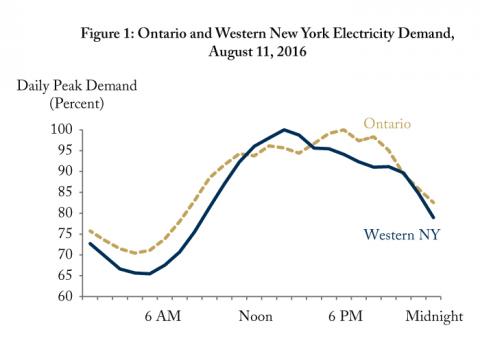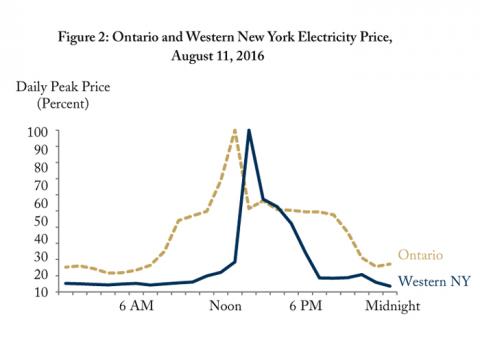From: Benjamin Dachis
To: Ontario Ministry of Energy
CC: Independent Electricity System Operator
Date: September 2nd, 2016
Re: Ontario should let markets lead to energy savings, not arbitrary rules
A few weeks ago, I showed what happened to electricity prices during the highest demand hour of the year so far in Ontario: 6 PM on August 10th.
What happened the next day is also interesting. It wasn’t the peak electricity demand day in Ontario, but it had the highest net demand hour on the Ontario electricity system. What’s the difference? Ontario is integrated into the continent-wide electricity grid. Electricity flows in and out of the province to go where it’s in most demand, subject to the physical constraints of transmission connections.
The early afternoon on August 11th saw the highest demand hour of the year so far in nearby Western New York (Figure 1). Prices there skyrocketed to US$633/MWh. Prices in Ontario were also high, at CAD$214 per MWh that hour (Figure 2), the second-highest daily average price in Ontario so far this year. Imports and exports into and out of Ontario were also near their annual high.
While August 10th at 6PM may have been the peak demand hour of the year within Ontario, prices didn’t spike because net market demand didn’t crack the top 85 readings so far this year. But because of Ontario’s Industrial Conservation Initiative policy that lets some large electricity consumers slash their annual electricity costs if they cut their electricity use during the top five Ontario-wide electricity demand hours of the year, the cost of electricity that hour was in effect, very high for businesses.
What’s the important takeaway? Prices in Ontario rose on August 11th to meet the demand of the overall market. They didn’t rise much on August 10th because the overall market signal was that electricity wasn’t in as high of demand. But that’s not the signal that Ontario businesses heard. Ontario’s Industrial Conservation Initiative policy uses the measure of Ontario demand to get businesses to save electricity, not the overall market. This shows how the arbitrary thresholds and market definitions in Ontario’s electricity pricing program are not as effective as market prices and demand at determining when customers should try to cut back on electricity. In an integrated market, policy measures driven by Ontario demand only give flawed signals of when to cut back, and when not to. The result is a greater cost than necessary to Ontario consumers.
Benjamin Dachis is Associate Director, Research, at the C.D. Howe Institute.
To send a comment or leave feedback, email us at blog@cdhowe.org.







